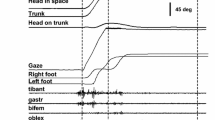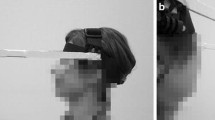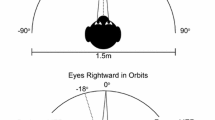Abstract
Although previous studies have demonstrated the existence of coordinated eye and head movements during gaze shifts, none has studied the temporal and spatial characteristics of the various body segments during gaze transfers that require whole body movements. Without this information it is not possible to determine the extent of the interaction between the oculomotor control system and the motor control systems responsible for moving other body parts. Presented here is a detailed analysis of the timing and kinematic characteristics of participants’ (N=5) eye, head, upper body and feet during rotation of their body to align with light cues positioned at eccentric locations (45, 90, and 135°, left and right of centre). For all rotation amplitudes there was a clear sequence of body segment orientation (eye, head, upper body and feet) consistent with previous studies of locomotor steering and significant correlations between the onset latency times of the eyes and all body segments. There were also significant correlations between temporally aligned kinematic profiles of the feet and the eye in space for all movement amplitudes. The extent of correlation was significantly lower for displacement profiles of the feet versus head and of the feet versus upper body. These findings demonstrate substantial eye-foot coordination during a novel whole-body rotation paradigm and provide evidence that the output of the motor systems responsible for moving the feet is heavily influenced by the motor systems responsible for generating and coordinating eye and head movements to peripheral targets.



Similar content being viewed by others
References
Bahill AT, Clark MR, Stark L (1975) The main sequence, a tool for studying human eye movements. Math Biosci 24:191–204
Baloh RW, Konrad HR, Sills AW, Honrubia V (1975) The saccade velocity test. J Neurol 25:1071–1076
Barnes GR (1979) Vestibulo-ocular function during co-ordinated head and eye movements to acquire visual targets. J Physiol 287:127–147
Bizzi E, Kalil RE, Tagliasco V (1971) Eye-head coordination in monkeys: evidence for centrally patterned organization. Science 173:424–454
Bizzi E, Kalil RE, Morasso P (1972) Two modes of active eye-head coordination in monkeys. Brain Res 40:45–48
Buttner U, Fuchs AF, Markert-Schwab G, Buckmaster P (1991) Fastigial nucleus activity in the alert monkey during slow eye and head movements. J Neurophysiol 65:1360–1371
Freedman EG, Sparks DL (1997a) Eye-head co-ordination during head unrestrained gaze shifts in rhesus monkeys. J Neurophysiol 77:2328–2348
Freedman EG, Sparks DL (1997b) Activity of cells in the deeper layers of the superior colliculus of the rhesus monkey: evidence for a gaze displacement command. J Neurophysiol 78:1669–1690
Freedman EG, Sparks DL (2000) Coordination of the eyes and head: movement kinematics. Exp Brain Res 131:22–32
Freedman EG, Stanford TR, Sparks DL (1996) Combined eye-head gaze shifts produced by electrical stimulation of the superior colliculus in rhesus monkeys. J Neurophysiol 76:927–952
Goldring JE, Doris MC, Corneil BD, Ballantyne PA, Munoz DP (1996) Combined eye-head gaze shifts to visual and auditory targets in humans. Exp Brain Res 111:68–78
Goosens HHLM, Van Opstal AJ (1997) Human eye-head coordination in two dimensions under different sensorimotor conditions. Exp Brain Res 114:542–560
Grasso R, Glasauer S, Takei Y, Berthoz A (1996) The predictive brain: anticipatory control of head direction for the steering of locomotion. Neuroreport 26:1170–1174
Grasso R, Prevost P, Ivanenko YP, Berthoz A (1998) Eye-head coordination for the steering of locomotion in humans: an anticipatory synergy. Neurosci Lett 253:115–118
Harting JK (1977) Descending pathways from the superior colliculus: an autoradiographic analysis in the rhesus monkey (Macaca mulatto). J Comp Neurol 173:583−612
Hollands MA, Marple-Horvat DE (2001) Coordination of eye and leg movements during visually guided stepping. J Motor Behav 33:205–216
Hollands MA, Marple-Horvat DE, Henkes S, Rowan AK (1995) Human eye movements during visually guided stepping. J Motor Behav 27:155–163
Hollands MA, Patla AE, Vickers JN (2002) “Look where you’re going!”: Gaze behaviour associated with maintaining and changing the direction of locomotion. Exp Brain Res 143:221–230
Huerta MF, Harting JK (1982) Tectal control of spinal cord activity: neuroanatomical demonstration of pathways connecting the superior colliculus with the cervical spinal cord grey. Prog Brain Res 57:293–328
Ito M (1984) The cerebellum and neural control. Raven Press, New York
Kalesnykas RP, Hallett PE (1994) Retinal eccentricity and the latency of eye saccades. Vision Res 34:517−531
Marple-Horvat DE, Criado JM, Armstrong DM (1998) Neuronal activity in the lateral cerebellum of the cat related to visual stimuli at rest, visually guided step modification and saccadic eye movements. J Physiol 506:489–514
Paré M, Crommelinck M, Guitton D (1994) Gaze shifts evoked by stimulation on the superior colliculus in the head-free cat conform to the motor map but also depend on stimulus strength and fixation activity. Exp Brain Res 101:123–139
Stanton GB, Goldberg ME, Bruce CJ (1988) Frontal eye field efferents in the macaque monkey II. Topography of terminal fields in the midbrain and pons. J Comp Neurol 271:493–506
Stein JF, Glickstein M (1992) Role of the cerebellum in the visual guidance of movement. Physiol Rev 72:967–1017
Thach WT, Goodkin HP, Keating JG (1992) The cerebellum and the adaptive coordination of movement. Annu Rev Neurosci 15:403–442
Van Gisbergen JAM, Van Opstal JA, Ottes FP (1984) Parametrization of saccadic velocity profiles in man. In: Gale AG, Johnson F (eds) Theoretical and applied aspects of eye movement research. Elsevier Science, New York, pp 87–94
Volle M, Guitton D (1993) Human gaze shifts in which the head and eyes are not initially aligned. Exp Brain Res 94:463–470
Zangemeister WH, Nagel M (2001) Transcranial magnetic stimulation over the cerebellum delays predictive head movements in the coordination of gaze. Acta Otolaryngol Suppl 545:140–144
Acknowledgements
This study was carried out in the Academic Department of Neuro-otology, Imperial College, London, with the support of a Wellcome Trust Prize International Traveling Research Fellowship awarded to Dr. Hollands under the sponsorship of Professor Bronstein. Support from the Medical Research Council and the CEC grant Access to Research Infrastructures is also gratefully acknowledged.
Author information
Authors and Affiliations
Corresponding author
Rights and permissions
About this article
Cite this article
Hollands, M.A., Ziavra, N.V. & Bronstein, A.M. A new paradigm to investigate the roles of head and eye movements in the coordination of whole-body movements. Exp Brain Res 154, 261–266 (2004). https://doi.org/10.1007/s00221-003-1718-8
Received:
Accepted:
Published:
Issue Date:
DOI: https://doi.org/10.1007/s00221-003-1718-8




